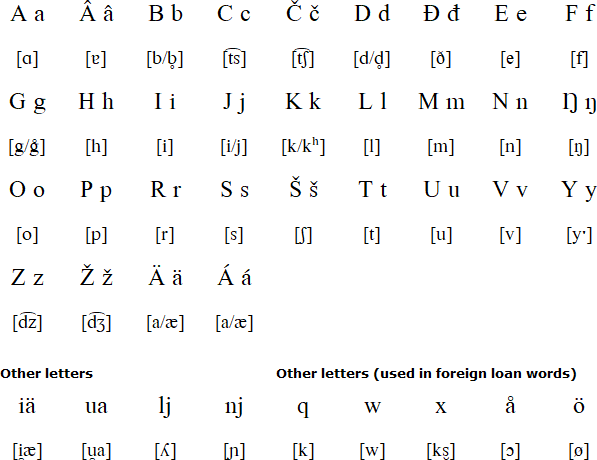Inari Saami is an Eastern Sámi language spoken in the municipality of Inari in Finland by about 300 speakers, 269 of whom speak it as a first language, according to the Sámi Parliament of Finland. The majority of speakers are middle-aged or elderly and the language is considered seriously endangered.
The first book in Inari Saami, Anar sämi kiela aapis kirje ja doctor Martti Lutherus Ucca katkismus by Edvard Wilhelm Borg, was published in 1859. A translation of the Bible in Inari Saami was published in 1906 and a small number of books have been appeared since then.
The Sámi people in Finland have had the right to use their own languages with government officials since 1992 in the areas where they have traditionally lived, including Inari, where Northern and Skolt Sámi are also spoken. However only 10% of public servants in the Inari-speaking region can actually speak Inari Saami, so the majority of them use Finnish.
The Inari Saami Language Association (Anarâškielâ servi) was set up in 1986 to promote the language. They produce various books, a newspaper (Kierâš online) and other publications, and have been running an immersion programme in Inari Saami for children between 3 and 6 years old since 1997, and the language has been taught in schools since the 1970s. Since 2005 Inari Saami has been used as a medium of instruction for the first four years of primary education.
Inari Saami is also used in music, and a CD of rap in the language was released in 2007.
The Inari Saami alphabet currently in use was officially adopted in 1996.

Information about the Inari Saami alphabet and pronunciation compiled by Wolfram Siegel.
Download alphabet charts for Sámi languages (Excel)
Pyeri peivi. Mun lam Hans Morottaja, 67 ihásâš anarâš. Mun lam varrim Anarist 1981 Helsigân. Mu päikki lâi Kaamasist, tärkkilubbooht Saammadjäävrist mii lii meccitáálu kukken tuárispeln. Tot uba kuávlu lii ävdin, ii ohtagen fastaässee innig aasa tobbeen. Tääl mun aasam Helsigist, tave Haagast. Tast maŋa ko mun Helsigan várrejim, lijjim pargoost Martinlaaksost Vantaa peln. Tot pargo lai suullan tegu táálualmaa pargo. Mun lijjim tast iáláttuu rái, mast lam lamaš jo muáddi ive. Mun lam Aanaar sámmilâš, anarâš. Anarâšah ääsih Anarist, Aanaarjäärvi pirrasijn. Mist lii mii jieččan kielâ, anarâškielâ, amid eres sämmiliih iá ollásáávt addii. Anarâškielâ sárnooh láá suullan 400-500. Eenab ko peeli anarâšain iá mááti innig eenikielâs. Ko anarâšah áásih Aanaarjäävri pirrasijn, te sij láá lamaš ain kuálásteijeeh, eenab ko eres sámmiliih. Tontet sij láá nobdum-uv kuálásteijeesämmilâžžân.
Information about Inari Saami | Numbers
Some of the information on this page was supplied by 이윤호
Information about Inari Saami
http://en.wikipedia.org/wiki/Inari_Sámi_language
http://www.samimuseum.fi/anaras/english/kieli/kieli.html
http://http-server.carleton.ca/~toivonen/pdf/lagb.pdf
Vocabulary in Inari Saami
http://www.uta.fi/~km56049/same/inarinsaame.html
Video about Inari Saami
http://video.helsinki.fi/Media-arkisto/inarin_saamelaiset.html
Anarâškielâ seervi (Inari Saami Language Association)
http://www.anaraskielaservi.net
Kierâš online (Inari Saami newspaper)
http://www.anaraskielaservi.net/kieras/
Akkala Sámi, Inari Saami, Kildin Sámi, Lule Sámi, Northern Sámi, Pite Sámi, Skolt Sámi, Southern Sámi, Ter Sámi, Ume Sámi
Languages written with the Latin alphabet
Page last modified: 25.12.23
[top]
You can support this site by Buying Me A Coffee, and if you like what you see on this page, you can use the buttons below to share it with people you know.

If you like this site and find it useful, you can support it by making a donation via PayPal or Patreon, or by contributing in other ways. Omniglot is how I make my living.
Note: all links on this site to Amazon.com, Amazon.co.uk
and Amazon.fr
are affiliate links. This means I earn a commission if you click on any of them and buy something. So by clicking on these links you can help to support this site.
[top]